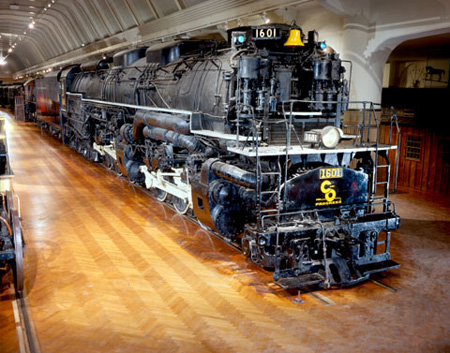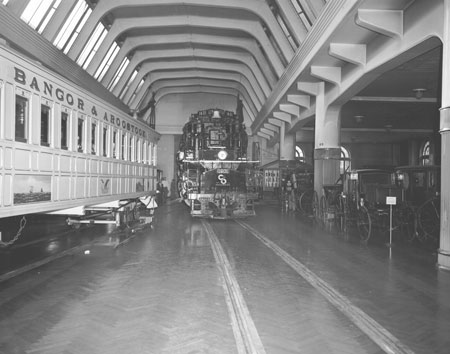Popular Research Topics
The Allegheny Locomotive
 |
Photo THF6423: ’Allegheny’ locomotive on the floor of The Henry Ford Museum.
Chesapeake & Ohio H-8 “Allegheny” Steam Locomotive #1601, 2-6-6-6 Type, Lima Locomotive Works, 1941. Object ID#56.50.1”
|
Why is it called the “Allegheny”?
The H-8 class was designed to haul heavy trains over the steep grades of the Allegheny Mountains—especially the route between Hinton, West Virginia and Clifton Forge, Virginia.
How many were originally made? How many are still in existence?
Lima Locomotive Works, of Lima, Ohio, made 60 Alleghenies for the Chesapeake & Ohio Railway from 1941-1948, locomotive #1601 was the second one built. The Virginian Railway purchased 8 Alleghenies from Lima Locomotive works in 1945. Only 2 Alleghenies survive: 1601, here at The Henry Ford, and 1604 at the Baltimore & Ohio Railroad Museum in Baltimore, Maryland.
What is the size, speed, strength and original cost of the Allegheny?
The Allegheny is 125-ft long, 11-ft 2-in wide, 16-ft 5 ½-in tall and weighs approximately 771,000-lbs. It could pull 160 coal cars, each with a 60-ton load, and if only pulling passenger cars, could run at 60 mph. 1601’s original price was $230,663.
When were the Alleghenies retired?
The C&O began replacing these steam locomotives with diesels in 1952; all were retired by 1956. 1601 was donated to The Henry Ford and was presented on July 9, 1956.
How did they get it into the museum?
1601 was brought up to the Detroit area “cold” (not under its own power) on the rear of a C&O freight train. It took three attempts to get 1601 into the museum. On the first attempt the locomotive derailed on the railroad tracks behind the museum. After removing its main and side rods it was time for a second attempt. This time the locomotive made it as far as the museum’s railroad door but was unable to pass through, even though the door had been widened to accommodate it. The problem was the switch just inside the building—as 1601 started to pass over this switch its articulation caused the cab to swing over much further than anticipated. On the third attempt, following temporary modifications and component removals, the Allegheny finally passed through the door and took its place in the museum’s main exhibition hall.
 |
| Photo THF8866: Third attempt to move ‘Allegheny’ into The Henry Ford museum, September 1956. |
Further Reading
Huddleston, Eugene L. and Thomas W. Dixon Jr. The Allegheny: Lima’s Finest. (Edmonds, Wash.: Hundman Publishing, 1984).
Huddleston, Eugene L. “Doctoring the Scales: The Case of the Overweight Alleghenies.” Trains, Vol. 58, no. 12 (December 1998): 78-85.
————. World’s Greatest Locomotives: C&O 2-6-6-6, Virginian 2-6-6-6, N&W 2-6-6-4, UP 4-8-8-4. (Lynchburg, Va.: TLC Publishing and Clifton Forge, Va.: C&O Historical Society, 2001).